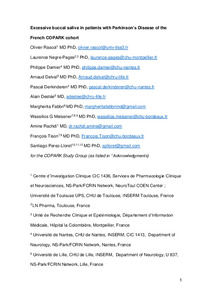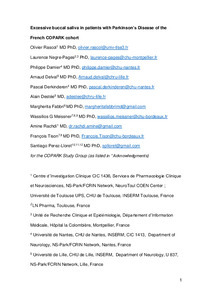Please use this identifier to cite or link to this item:
https://repositorio.uca.edu.ar/handle/123456789/10859| Título: | Excessive buccal saliva in patients with Parkinson’s Disease of the French COPARK cohort | Autor: | Rascol, Olivier Negre-Pages, Laurence Damier, Philippe Delval, Arnaud Derkinderen, Pascal Destée, Alain Fabbri, Margherita Meissner, Wassilios G. Rachdi, Amine Tison, François Pérez Lloret, Santiago |
Palabras clave: | ENFERMEDAD DE PARKINSON; GLANDULAS SALIVALES; SISTEMA NERVIOSO AUTONOMO; CALIDAD DE VIDA; TRATAMIENTO MEDICO; ENFERMEDADES NEUROGENERATIVAS | Fecha de publicación: | 2020 | Editorial: | Springer Nature | Cita: | Rascol, O., et al. Excessive buccal saliva in patients with Parkinson’s disease of the French COPARK cohort [en línea]. Postprint del articulo publicado en Journal of Neural Transmission, 2020. doi:10.1007/s00702-020-02249-0. Disponible en: https://repositorio.uca.edu.ar/handle/123456789/10859 | Resumen: | Abstract: Introduction: We describe excessive buccal saliva (EBS) prevalence in patients with Parkinson’s Disease (PD) and controls of the COPARK study, its changes between “ON” and OFF” conditions and over time, its impact on Health-related Quality of life (HRQoL), and factors associated with this condition. Methods: We studied 671 ambulatory PD patients and 177 age/sex-matched controls. We defined “sialorrhea” as UPDRS item #6 (salivation)=1 or 2; and “drooling” as item #6=3 or 4. SCOPA-Aut drooling score (item #2) was also available in a subset (45%) of the cohort. HRQoL was assessed by the PDQ-39 and SF-36 scales. Twenty-four months follow-up data was available in 401/671 patients. Results: EBS as assessed by UPDRS was present in 38% of PD patients in the “ON” condition (“Sialorrhea”: 35%; “drooling”: 3%). There were also more PD patients reporting “drooling” than controls according to the SCOPA-Aut (49% vs 19%, p<0.01). UPDRS salivation score was worse in the “OFF” vs “ON” condition in PD patients with motor fluctuations (0.90±0.94 vs 0.54±0.79, p<0.01). UPDRS salivation score worsened after 24 months of follow up (0.47±0.70 vs 0.64±0.81, p<0.01). Worse PDQ-39 scores were observed in PD patients with EBS in bivariate but not in multivariate analyses. EBS was directly related to PD duration and severity, male gender, dysphagia, hypomimia, and autonomic dysfunction (logistic regression). Conclusions: EBS was more frequent in PD patients than controls, worsened in the “OFF” condition and after 24 months of follow-up, moderately affected HRQoL and was correlated with indices of bradykinesia, dysphagia, and autonomic dysfunction. | URI: | https://repositorio.uca.edu.ar/handle/123456789/10859 | ISSN: | 0300-9564 (impreso) 1435-1463 (online) |
Disciplina: | MEDICINA | DOI: | 10.1007/s00702-020-02249-0 | Derechos: | Acceso abierto. 12 meses de embargo | Fuente: | Postprint del articulo publicado en Journal of Neural Transmission, 2020 |
| Appears in Collections: | Artículos |
Files in This Item:
| File | Description | Size | Format | |
|---|---|---|---|---|
| excessive-buccal-saliva.pdf | 296,67 kB | Adobe PDF |  View/Open | |
| excessive-buccal-saliva.pdf.jpg | 21,68 kB | JPEG |  View/Open |
Page view(s)
123
checked on Apr 30, 2024
Download(s)
270
checked on Apr 30, 2024
Google ScholarTM
Check
Altmetric
Altmetric
This item is licensed under a Creative Commons License

